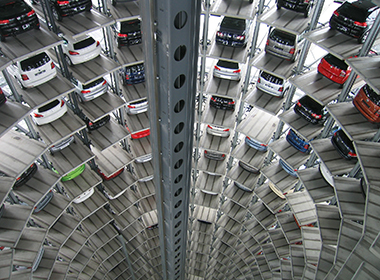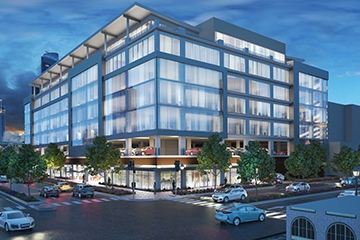Original Source: "The Future of Parking is Happening Now" by Matt Davis for the Parking Professional, August 2017
 Automated and mechanical parking utilize volume instead of levels to create sufficient parking.
Automated and mechanical parking utilize volume instead of levels to create sufficient parking.
How do we design parking for the future? Speculation on when driverless cars will hit the roads in numbers and how dramatically they will shift the urban landscape is evolving daily, with the only constant being that change is coming. In a future dominated by the driverless car, most see an urban landscape where public space replaces street and on grade parking and a there is a gradual decrease in the need for structured parking. These dynamics are changing the way we think about parking design.
The future of parking isn’t just something limited to our imagination. Urban areas are already confronting the question of how to create more parking with less space due to rising real estate, labor and construction costs, giving us an early look at how parking will continue to evolve whether we cling to our steering wheels or get whisked to work each day on literal autopilot.
Making Today Work for Tomorrow
Have you parked in a big city lately? The odds are increasing that your parking space will be accessed by mechanical lift, car shuttle or car elevator. That’s because dozens of new projects every day are exploring alternatives to traditional parking, such as mechanical and automated parking systems. As density continues to increase and construction costs go up, developers, downtowns and even college campuses are exploring their options for utilizing volume instead of levels to create sufficient parking.
 Driverless cars, such as the fleet of "taxibots" shown here, provide the potential for dramatic efficiency improvements, resulting in unused space that can be repurposed.
Driverless cars, such as the fleet of "taxibots" shown here, provide the potential for dramatic efficiency improvements, resulting in unused space that can be repurposed.
This is an important mindset when we consider how driverless cars will impact parking design. If we imagine a world where autonomous cars have removed people from the parking equation, parking structures of the future won’t have to accommodate infrastructure designed for humans, resulting in a smaller overall footprint for the same number of parking stalls. Therefore retrofitting today’s parking structure to house driverless cars will result in unused space. Finding ways to repurpose the extra space is one of the challenges we’re going to face, and parking innovations of today can help us get there.
Car elevators, for instance, can eliminate the need for ramped floors that would interfere with converting a parking structure to an occupied space. Mechanical lifts require higher floor-to-floor heights that are more compatible with human use than a typical parking structure, which creates more possibilities for converting parking to occupied space. Automated systems can be assembled, modified, disassembled and removed as needed. State of the art robotic and fully automated parking structures on the market today have already streamlined their parking footprint by eliminating human accommodations that are no longer needed when people are not part of the parking process, such as pedestrian pathways and space allowances for opening and closing car doors. When driverless cars truly become the norm, little if any modification may be needed to make these structures more efficient storage places for vehicles not actively in use.
A Changing Landscape
It’s not a seamless portal into the future. Most automated parking systems are located below grade, which could provide challenges should the space later need repurposing for human use. But even that is changing; architects and enterprising entrepreneurs are already taking on the challenge of creating compelling underground spaces. For instance, Trinity Properties in San Francisco has plans to open a subterranean grocery store. New York is currently home to Lowline, the world’s first underground park. A former missile silo in Stockholm now houses a data center, complete with waterfalls.
The advent of driverless cars won’t eliminate the need for parking, but it is changing the way we think about it. By continuing to find innovative, out of the box solutions to today’s parking challenges, we are paving the way for tomorrow. So the next time you park, take a look around. You might be parking in the future.







